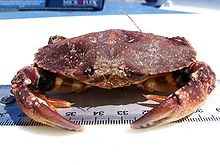- Metacarcinus gracilis
-
Metacarcinus gracilis 
Scientific classification Kingdom: Animalia Phylum: Arthropoda Subphylum: Crustacea Class: Malacostraca Order: Decapoda Infraorder: Brachyura Superfamily: Cancroidea Family: Cancridae Genus: Metacarcinus Species: M. gracilis Binomial name Metacarcinus gracilis
(Dana, 1852) [1]Synonyms Cancer gracilis Dana, 1852 [1]
Metacarcinus gracilis or more commonly the graceful rock crab or slender crab, is one of only two members of the genus Metacarcinus whose chelae (claws) are white tipped, the other crab being M. magister (Dungeness crab).[2] Cancer gracilis has been caught from Alaska to Bahía Magdelena, Baja California.[3] Although M. gracilis is only found in the Pacific Ocean, it has cousins in the Atlantic Ocean. The genus Cancer (sensu lato) apparently evolved in the Pacific Ocean and later migrated to the Atlantic Ocean.[4] Larvae and small juveniles of this species are often seen riding jellyfish, especially Phacellophora camtschatica. The juvenile crabs steal food from the jellyfish and also clean off parasitic amphipods.[5]
Morphology
Like the other members of the family Cancridae, the slender crab has a very broad and oval carapace with dull tooth-like protrusions toward the front of the carapace. Female crabs can be distinguished from males by the broad tail flap on their undersides, which are used for protecting their eggs when they are gravid. The slender crab usually has a carapace that is olive brown and legs that vary from yellowish brown to purple. M. gracilis only grows to a width of about 3.5 inches (9 cm) and resembles a juvenile M. magister. Often the two species can be confused as M. gracilis looks very similar to a juvenile Dungeness crab. They can readily be distinguished from each other however by the appearance of hair on the posterior three legs of M. magister where M. gracilis is almost always hairless. Another telling characteristic of the slender crab is that the last segment of its tail flap is pointed, where M. magister is curved.
References
- ^ a b P. K. L. Ng, D. Guinot & P. J. F. Davie (2008). "Systema Brachyurorum: Part I. An annotated checklist of extant Brachyuran crabs of the world". Raffles Bulletin of Zoology 17: 1–286. http://rmbr.nus.edu.sg/rbz/biblio/s17/s17rbz.pdf.
- ^ Eugene N. Kozloff (1993) Seashore Life of the Northern Pacific Coast. Seattle: University of Washington Press.
- ^ J. D. Nations (1975) The genus Cancer (Crustacea: Brachyura): Systematics, biogeography and fossil record. Natural History Museum of Los Angeles County Science Bulletin 23: 1-104.
- ^ Michelle K. Harrison and Bernard J. Crespi (1999). "Phylogenetics of Cancer Crabs (Crustacea: Decapoda: Brachyura)" (PDF). Molecular Phylogenetics and Evolution 12: 186–199. doi:10.1006/mpev.1998.0608. PMID 10381321. http://decapoda.arthroinfo.org/pdfs/4160/4160.pdf.
- ^ Trisha Towanda & Erik V. Thuesen (2006). "Ectosymbiotic behavior of Cancer gracilis and its trophic relationships with its host Phacellophora camtschatica and the parasitoid Hyperia medusarum". Marine Ecology Progress Series 315: 221–236. doi:10.3354/meps315221.
Categories:- Cancroidea
- Indo-Pacific crustaceans
- Animals described in 1852
Wikimedia Foundation. 2010.
